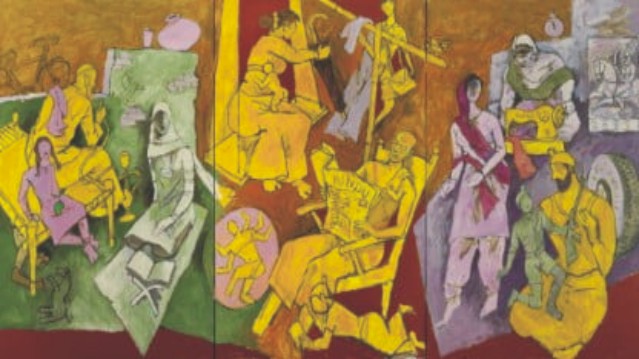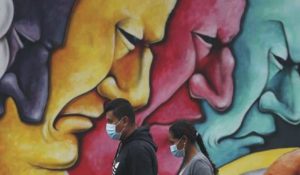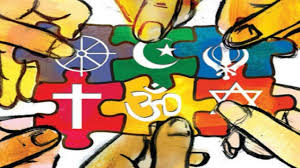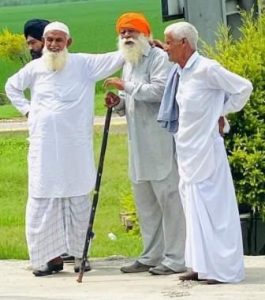

Unity in diversity is a phrase we all picked up in our school years. Enjoying the Ramlila festivities for the ten days to Vijayadashami ran parallel to watching the Tazia processions or the Jaina processions with slogans of Vande Viram (Hail Lord Mahavira), the celebrations of Dalits on the day Babasaheb Ambedkar embraced Buddhism, and the celebration of Christmas. These diversity experiences were deeply rooted in how Indians marked various festivals—it was experiential, not just in the realm of theory.
In Indian society, diversity goes as far back as the imagination can. Christianity is older in India than many countries with far larger Christian populations. Right in the seventh century, Islam became a part of this land. The Shaka, Kushana, Hunas, and Greeks added their flavours to our culture.

How did diversity become so deep-rooted in our culture? While there was ethnic strife, the social conditions settled into coexistence and harmony between religious streams.
The Ashokan edicts ask for mutual respect between members of different religions (which included Buddhism, Brahmanism, Jainism, and the Ajivikas). Much later, the Mughal ruler Akbar promoted Deen-e-Ilahi and Sulh-e-Kul. In his book Majma Ul Baharayn, Dara Shukoh described India as a vast ocean made of two seas, Hinduism and Islam.
The Bhakti saints such as Kabir, Ramdeo Baba peer, Tukaram, Namdeo and Narsi Mehta drew followers from Hindus and Muslims. Sufi saints such as Nizamuddin Auliya, Muin al-Din Chishti, and Haji Malang became part of the Indian ethos. These saints embraced all the people irrespective of their religion and caste. They melded with the local culture fully.
During the colonial period, divisive tendencies in the name of religion reared their head due to the British policy of divide and rule. The elite sections of society initiated and encouraged these tendencies. However, they were overshadowed by the integrative and all-inclusive freedom movement.
It is here that the magical interpretation of Hinduism by Gandhi succeeded in mobilising people of all religions within the single thread of Indian nationalism. The charisma of Gandhi’s movements left a deep impression on people of all faiths. People recited shlokas from the Gita and verses from the Koran and the Bible in his prayer meetings.
During this period, we saw Maulana Abul Kalam Azad, Shaukatullah Shah Ansari, Khan Abdul Ghaffar Khan, Allah Bakhsh, and many others rubbed shoulders with Jawaharlal Nehru, Sardar Patel and other leaders of the freedom movement. Diversity added richness and strength to the composite notion of Indian nationalism.
 Cultural values drew heavily from interactions in subtle and profound ways, influencing all aspects of our life from food habits, literature, art, music, architecture and what have you.
Cultural values drew heavily from interactions in subtle and profound ways, influencing all aspects of our life from food habits, literature, art, music, architecture and what have you.
For the last few decades, events in India appear to be moving in the reverse direction, detrimental to peace and harmony.
On the positive side, we witness the bubbling up of integrative efforts within and beyond religion.
We had eminent social workers such as Swami Agnivesh and Asghar Ali Engineer, who promoted interfaith dialogue and sought to remove misunderstandings between members of different faiths.
Many crusaders are silently working in society—Martin McWan, John Dayal and Cedric Prakash come to mind—who dedicated their lives to promote harmony. Such movements of interfaith dialogue went a long way in reducing theological and social misunderstanding among Hindus and Muslims and members of other faiths.
 Their initiative contributed in profound ways to maintaining amity between diverse groups. Each in their own way has come to imprint harmony on all of society.
Their initiative contributed in profound ways to maintaining amity between diverse groups. Each in their own way has come to imprint harmony on all of society.
Faisal Khan revived Khudai Khidmatgar, the organisation Khan Abdul Gaffar Khan founded. This grassroots organisation promotes amity and the spirit of mutual respect between Hindus and Muslims. They launched an open house—Apna Ghar—a system wherein members from all communities can live together and share their practices with others in a respectful way.
Noted film maker Anand Patwardhan wrote, “…the Khudais have touched people’s hearts across the country and membership has swelled to 50,000. Today it has many Hindus, including a few who had once been in the RSS.”
India has been the site of many ghastly lynchings. The families of the victims have no social support and are desperately helpless. To empathise with them, social activist Harsh Mander started the Karwan-e-Mohabbat—Caravan of Love—that reaches out to the families of the victims of lynching to extend moral and social support. It has come as significant assistance to families and communities.
Many cities have communal harmony groups today and charity groups that help all, even though we may not hear about them much. These groups are working silently, unnoticed, while the violence of groups that promote divisiveness always hog the limelight.
 Even the farmer movement, the most significant post-independence mass movement, has promoted communal amity in a big way. Similarly, the Shaheen Bagh protests strengthened intercommunity amity.
Even the farmer movement, the most significant post-independence mass movement, has promoted communal amity in a big way. Similarly, the Shaheen Bagh protests strengthened intercommunity amity.
The deeper problem is the global rise of those who believe in the “clash of civilisations” thesis and promote divisive tendencies. India is no exception. A United Nations-sponsored high-level committee when Kofi Annan was Secretary-General put forward the notion of an ‘Alliance of Civilisations’.
This is the guiding principle of many groups who wish to revive India’s syncretic traditions. In the current troubling scenario, these rays of hope are lesser-known but critical for a peaceful future. ![]()
_____________
Also Read:
Centre’s Opaque Auction Rules For Pulses Rip Off Govt Coffers, Help Millers Strike Rich
Need to amend laws like UAPA to provide for punishment for those who slap false cases
Global Arms Trade: Who are the real winners?
Why not 40 pc tickets for women in Punjab and elsewhere?
Punjab – How a deadly cocktail of Agri-Water-Energy nexus going to destroy it?
North Pole and the ideological conflict of RSS & Hindutva
Politics of Symbolism: Dalit Chief Ministers in India

Disclaimer : PunjabTodayTV.com and other platforms of the Punjab Today group strive to include views and opinions from across the entire spectrum, but by no means do we agree with everything we publish. Our efforts and editorial choices consistently underscore our authors’ right to the freedom of speech. However, it should be clear to all readers that individual authors are responsible for the information, ideas or opinions in their articles, and very often, these do not reflect the views of PunjabTodayTV.com or other platforms of the group. Punjab Today does not assume any responsibility or liability for the views of authors whose work appears here.
Punjab Today believes in serious, engaging, narrative journalism at a time when mainstream media houses seem to have given up on long-form writing and news television has blurred or altogether erased the lines between news and slapstick entertainment. We at Punjab Today believe that readers such as yourself appreciate cerebral journalism, and would like you to hold us against the best international industry standards. Brickbats are welcome even more than bouquets, though an occasional pat on the back is always encouraging. Good journalism can be a lifeline in these uncertain times worldwide. You can support us in myriad ways. To begin with, by spreading word about us and forwarding this reportage. Stay engaged.
— Team PT


Copyright © Punjab Today TV : All right Reserve 2016 - 2025 |